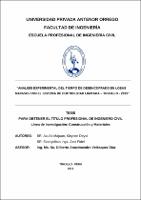Mostrar el registro sencillo del ítem
Análisis experimental del tiempo de desencofrado en losas macizas con el sistema de ductibilidad limitada - Trujillo - 2019
| dc.contributor.advisor | Velásquez Díaz, Gilberto Anaximandro | |
| dc.contributor.author | Acuña Majuan, Kleysen Deyvi | |
| dc.contributor.author | Evangelista Inga, Alex Fidel | |
| dc.creator | Acuña Majuan, Kleysen Deyvi | |
| dc.date.accessioned | 2020-01-13T17:25:14Z | |
| dc.date.available | 2020-01-13T17:25:14Z | |
| dc.date.issued | 2019 | |
| dc.identifier.uri | https://hdl.handle.net/20.500.12759/5933 | |
| dc.description.abstract | La presente investigación tuvo la finalidad de optimizar el tiempo de desencofrado de los edificios con sistemas de ductibilidad limitada, que en la actualidad tiene bastante utilización en las construcciones de todo el país. Debido a la necesidad de generar el máximo avance en el proceso de ejecución se deben desencofrar estructuras parcialmente endurecidas que tienen que soportar los pesos de los niveles superiores transmitidos por los puntales de manera uniforme. En la determinación de las cargas actuantes en la losa se calcularon los pesos que se generaron en los días siguientes a su vaciado, que luego se analizaron en Etabs para obtener los momentos últimos que se generaban en diferentes días. Además, se realizaron ensayos a flexión de prototipos de la losa maciza y ensayo a comprensión de probetas cilíndricas que se verificaron de acuerdo a las normas establecidas. Obteniendo la evolución el concreto y el módulo de rotura de la losa a diferentes edades. Posteriormente se verifico las resistencias requeridas por las losas con los módulos de rotura para comprobar alguna ruptura en determinado día, después comparamos la evolución de la resistencia del concreto en obra con la resistencia requeridas por la losa y concluimos que a las 24 horas de vaciado del concreto se puede desencofrar sin que tenga ninguna ruptura en la losa maciza, teniendo un aproximado del 30% de la resistencia total del diseño. | es_PE |
| dc.description.abstract | The purpose of this research was to optimize the stripping time of buildings with limited ductility systems, which is now widely used in constructions throughout the country. Due to the need to generate the maximum advance in the execution process, partially hardened structures must be stripped, which must support the weights of the upper levels transmitted by the props in a uniform manner. In determining the loads acting on the slab, the weights generated in the days following its emptying were calculated, which were then analyzed in Etabs to obtain the last moments generated in different days. In addition, bending tests were carried out on prototypes of the solid slab and compression tests were carried out on cylindrical specimens that were verified according to established standards. Obtaining the evolution of the concrete and the modulus of breakage of the slab at different ages. Subsequently, the resistances required by the slabs were verified with the breaking modules to check for any rupture on a given day, then we compared the evolution of the resistance of the concrete on site with the resistance required by the slab and we concluded that after 24 hours of pouring the concrete can be stripped without having any rupture in the solid slab, having an approximate 30% of the total resistance of the design. | en_US |
| dc.description.uri | Tesis | es_PE |
| dc.format | application/pdf | es_PE |
| dc.language.iso | spa | es_PE |
| dc.publisher | Universidad Privada Antenor Orrego - UPAO | es_PE |
| dc.relation.ispartofseries | T_ING.CIVIL_1830 | |
| dc.rights | info:eu-repo/semantics/closedAccess | es_PE |
| dc.source | Universidad Privada Antenor Orrego | es_PE |
| dc.source | Repositorio Institucional - UPAO | es_PE |
| dc.subject | Desencofrado | es_PE |
| dc.subject | Sistema de ductibilidad limitada | es_PE |
| dc.subject | Losas macizas | es_PE |
| dc.title | Análisis experimental del tiempo de desencofrado en losas macizas con el sistema de ductibilidad limitada - Trujillo - 2019 | es_PE |
| dc.type | info:eu-repo/semantics/bachelorThesis | es_PE |
| thesis.degree.level | Título Profesional | es_PE |
| thesis.degree.grantor | Universidad Privada Antenor Orrego. Facultad de Ingeniería | es_PE |
| thesis.degree.name | Ingeniero Civil | es_PE |
| thesis.degree.discipline | Ingeniería Civil | es_PE |
Ficheros en el ítem
Este ítem aparece en la(s) siguiente(s) colección(es)
-
Ingeniería Civil [1085]

